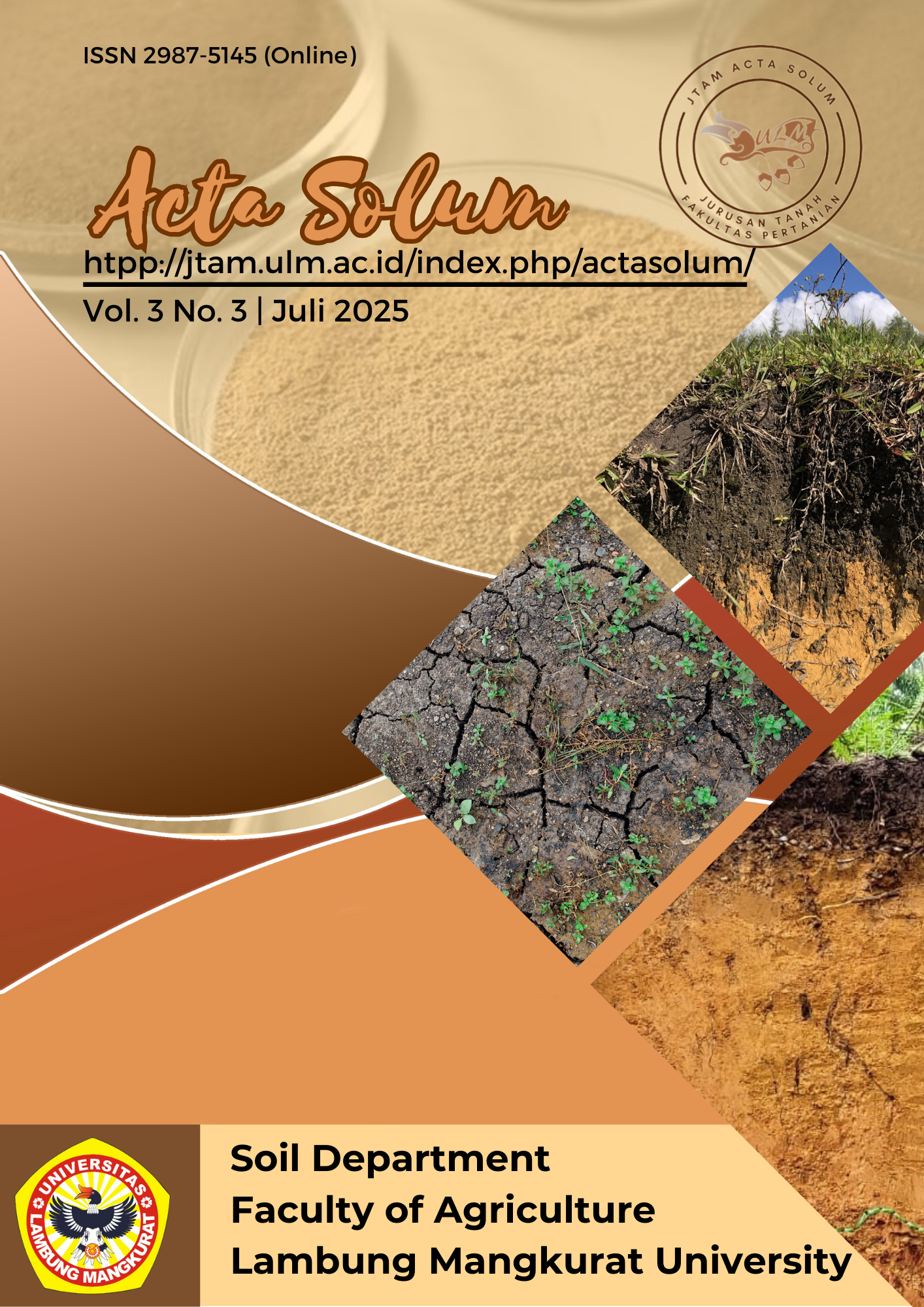Exploration of Bacteria in Red Chili Plant Soil with Potential as Plant Growth Promoting Rhizobacteria (PGPR)
Abstract
Soil fertility depends on the availability of sufficient nutrients for plant absorption. Chemical fertilizers can be used to provide sufficient N and P, but this affects soil health. The presence of rhizobacteria act as biofertilizers by increasing nutrients and altering soil formation, especially in the phosphate and nitrogen cycles. Phosphate-solubilizing and nitrogen-fixing bacteria play a role in increasing soil fertility and improving unstable soil properties. This study aims to identify rhizobacteria that have the potential as PGPR to increase N and P levels in the soil. Soil samples were collected randomly at a depth of 10 cm around chili plant roots. Bacteria were isolated using serial dilution and cultured on Pikovskaya medium. A total of 27 isolates produced clear zones with the highest solubility index and were inoculated on Nitrogen-Free Bromthymol Blue Agar (NFB) to evaluate N fixation through a color change from green to blue, as well as hypersensitivity tests on tobacco plants. Isolates showing the highest P solubility, highest N fixation ability, and no necrosis in tobacco were inoculated into sterile soil to analyze compound changes. Soil N content was measured using the Kjeldahl method, while phosphate levels were analyzed using the Bray I and HCl methods. The results of the study showed that the addition of KE2.15 isolate to the soil after 4 weeks of application increased the total organic N and available P content, making it a potential biofertilizer.
References
Adnan, M., Fahad, S., Saleem, M. H., & Lal, R. 2025. Sustainable phosphorus management in calcareous soils: problems and prospects. Journal of Plant Nutrition, 1–22. https://doi.org/10.1080/01904167.2025.2477269
Amalia, D. R., & Ziaulhaq, W. 2022. Pelaksanaan Budidaya Cabai Rawit sebagai Kebutuhan Pangan Masyarakat. Agriculture and Environmental Analytics, 1(1), 27–36. https://doi.org/10.55927/ijaea.v1i1.812
Daniel, R., Utomo, A. D. A. N., & Setyoko, Y. A. 2022. Racangan Bangun Alat Monitoring Kelembaban, PH Tanah dan Pompa Otomatis pada Tanaman Tomat dan Cabai. LEDGER: Journal Informatic and Information Technology, 1(4), 161–170. https://doi.org/10.20895/ledger.v1i4.862
Greed, S. 2023. Unveiling the final nitrogenase. Nature Reviews Chemistry, 7(6), 379–379. https://doi.org/10.1038/s41570-023-00507-9
Hasan, A., Tabassum, B., Hashim, M., & Khan, N. 2024. Role of plant growth promoting rhizobacteria (PGPR) as a plant growth enhancer for sustainable agriculture: A review. Bacteria, 3(2), 59–75. https://doi.org/10.3390/bacteria3020005
Ichwan, B., Novita, T., Eliyanti, E., & Masita, E. 2021. Aplikasi Berbagai Jenis Plant Growth Promoting Rhizobacteria (PGPR) dalam Meningkatkan Pertumbuhan dan Hasil Cabai Merah. Jurnal Media Pertanian, 6(1), 1–7. http://dx.doi.org/10.33087/jagro.v6i1.111
Khastini, R. O., Avilia, A., Salsabila, N., Febrianty, R. E., Aisy, R., & Frandista, S. C. 2024. Literature Review: Peranan Acaulospora Terhadap Penyerapan Fosfor Pada Akar Tanaman Singkong. Jurnal Tanah dan Sumberdaya Lahan, 11(2), 301–308. https://doi.org/10.21776/ub.jtsl.2024.011.2.1
Mohamed, E. A., Farag, A. G., & Youssef, S. A. 2018. Phosphate solubilization by Bacillus subtilis and Serratia marcescens isolated from tomato plant rhizosphere. Journal of Environmental Protection, 9(03), 266. https://doi.org/10.4236/jep.2018.93018
Pan, L., & Cai, B. 2023. Phosphate-solubilizing bacteria: advances in their physiology, molecular mechanisms and microbial community effects. Microorganisms, 11(12), 2904. https://doi.org/10.3390/microorganisms11122904
Patra, D., & Mandal, S. 2023. Non-rhizobia are the alternative sustainable solution for growth and development of the nonlegume plants. Biotechnology and Genetic Engineering Reviews, 39(2), 435–464. https://doi.org/10.1080/02648725.2022.2152623
Prakoso, T., Alpandari, H., Hendro, H., & Sridjono, H. 2022. Respon Pemberian Unsur Hara Makro Essensial Terhadap Pertumbuhan Tanaman Jagung (Zea Mays) (Response Of Essential Macro Nutrients To The Growth Of Corn Plants (Zea mays)). Muria Jurnal Agroteknologi, 1(1), 8–13. https://doi.org/10.24176/mjagrotek.v1i1.8217
Purwaningtyas, D. M., & Nuraini, Y. 2022. Pengaruh Mikroorganisme Lokal Rebung dan Plant Growth Promoting Rhizobacteria Terhadap Nitrogen Tanah Total, Populasi Bakteri Dan Produksi Kacang Tanah (Arachis hypogaea L). Jurnal Tanah dan Sumberdaya Lahan, 9(2), 365–373. https://doi.org/10.21776/ub.jtsl.2022.009.2.17
Saida, S., Samsul, N., & Edy, E. 2024. Isolasi Dan Uji Aktivitas Bakteri Pelarut Fosfat Dari Rhizosfer Tanaman Padi (Oryza sativa L.) Pada Fase Vegetatif Dan Generatif. Agrotek: Jurnal Ilmiah Ilmu Pertanian, 8(2), 147–155. https://doi.org/10.33096/agrotek.v8i2.620
Shah, F., & Wu, W. 2019. Soil and crop management strategies to ensure higher crop productivity within sustainable environments. Sustainability, 11(5), 1485. https://doi.org/10.3390/su11051485
Sirappa, M. P., Lahati, B. K., Rahmah, N., Fitra, R. A., Adawiyah, R., Rachman, R. M., & Hidayat, B. 2023. Kesuburan Tanah. Tohar Media. Retrieved from https://books.google.co.id/books?hl=en&lr=&id=MNXzEAAAQBAJ&oi=fnd&pg=PA133&dq=Sirappa,+M.+P.,+Lahati,+B.+K.,+Rahmah,+N.,+Fitra,+R.+A.,+Adawiyah,+R.,+Rachman,+R.+M.,+%26+Hidayat,+B.+Kesuburan+Tanah.+Tohar+Media&ots=G3-fAriKyW&sig=QFE76-h_8YKUOf7lIOGusU-vn8Q&redir_esc=y#v=onepage&q&f=false
Sukamto, S., & Rahmat, A. 2023. Evaluation of FTIR, macro and micronutrients of compost from black soldier fly residual: In context of its use as fertilizer. ASEAN Journal of Science and Engineering, 3(1), 21–30. Retrieved from https://ejournal.kjpupi.id/index.php/ajse/article/view/312/296
Tarigan, D. M., Barus, W. A., Munar, A., & Lestami, A. 2023. Exploration and morphological characterization of phosphate-solubilizing and nitrogen-fixing bacteria in saline soil. SABRAO Journal of Breeding & Genetics, 55(2). https://doi.org/10.54910/sabrao2023.55.2.27
Timofeeva, A. M., Galyamova, M. R., & Sedykh, S. E. 2023. Plant growth-promoting soil bacteria: nitrogen fixation, phosphate solubilization, siderophore production, and other biological activities. Plants, 12(24), 4074. https://doi.org/10.3390/plants12244074
Usman, N. I., & Wali, M. M. 2024. Nitrogen fixation by rhizobacterial nif mechanism: an advanced genetic perspective. In Updates on Rhizobacteria. IntechOpen. https://doi.org/10.5772/intechopen.1004087
Wei, X., Xie, B., Wan, C., Song, R., Zhong, W., Xin, S., & Song, K. 2024. Enhancing soil health and plant growth through microbial fertilizers: Mechanisms, benefits, and sustainable agricultural practices. Agronomy, 14(3), 609. https://doi.org/10.1016/j.ecoenv.2025.117703
Widya, D. A. S., Sabdaningsih, A., & Ayuningrum, D. 2024. Isolation and characterization morphology of nitrogen-fixing bacteria from mangrove sediment. https://doi.org/10.54660/.IJMRGE.2024.5.3.750-754
Wu, H., & Ge, Y. 2019. Excessive application of fertilizer, agricultural non-point source pollution, and farmers’ policy choice. Sustainability, 11(4), 1165. https://doi.org/10.3390/su11041165.
Xing, Y., Wang, X., & Mustafa, A. 2025. Exploring the link between soil health and crop productivity. Ecotoxicology and environmental safety, 289, 117703. https://doi.org/10.1016/j.ecoenv.2025.117703
Zhang, X. K., Zhang, G. Z., & Liang, W. J. 2022. Partial organic substitution weakens the negative effect of chemical fertilizer on soil micro-food webs. Journal of Integrative Agriculture, 21(10), 3037–3050. https://doi.org/10.1016/j.jia.2022.07.043.
Copyright (c) 2025 Miladiarsi Miladiarsi

This work is licensed under a Creative Commons Attribution-ShareAlike 4.0 International License.














